

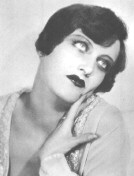
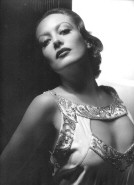




The Best of D
 Daisy
Kenyon. 20th Century-Fox, 1947. Directed by Otto Preminger, 99 minutes.
Daisy
Kenyon. 20th Century-Fox, 1947. Directed by Otto Preminger, 99 minutes.
Joan is the title character, a commercial artist in post-war Greenwich Village torn between a married lawyer (Dana Andrews) and a troubled war vet (Henry Fonda). Says Joan in CWJC: ...if Otto Preminger hadn't directed it the picture would have been a mess. The script was cliche. The usual triangle helped out by two very handsome young men...It came off. Sort of.
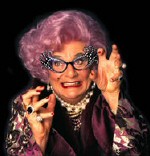 Dame Edna.
Australian performance artist Barry Humphries' alter ego; in full, "Dame
Edna Everage." Dame Edna became well-known on British TV in the '60s and
remained a star of TV and stage up until her final BBC appearance in 2019. Humphries
died in April 2023.
Dame Edna.
Australian performance artist Barry Humphries' alter ego; in full, "Dame
Edna Everage." Dame Edna became well-known on British TV in the '60s and
remained a star of TV and stage up until her final BBC appearance in 2019. Humphries
died in April 2023.
In 1989, she interviewed
Joan's first husband Doug Fairbanks, Jr., on her British TV show "The Dame
Edna Experience":
Dame Edna: Well, darling, you escaped from your family into a very early marriage, didn't you, Douglas?
Doug Jr.: I was, um...I defied the wishes of my family and went and got married when I was 19 for the first time.
Dame Edna: And who was the lucky girl?
Doug Jr.: I don't know how lucky she was. Joan Crawford.
Dame Edna: You old name dropper!
Doug Jr.: Wife dropper.
Dame Edna: Oh, wife dropper! It's spooky this, you know, Douglas, because my son Kenny is the president of the Australian Joan Crawford fan club.
Doug Jr.: Oh, really? Wow.
Dame Edna: And you're the founder member, aren't you? With the emphasis on 'member', I would say!
Doug Jr.: {Laughs}
Dame Edna: But, uh, be that as it may...Joan, well, you came to the parting of the ways, as we do in human relationships. Sorry, but we do, call me old-fashioned! I think I can say this now without fear of successful contradiction: Joan became a bit of a rat-bag, didn't she?
Doug Jr.: {Laughs}
Dame Edna: No, I mean this very nicely...I did! She had some funny little ways.
Doug Jr.: Yes, she was a very nice, normal, dedicated, hard-working girl, but she always liked to use substitute words for things.
Dame Edna: What, for example?
Doug Jr.: Oh, well, one thing that immediately comes to mind, in this sort of funny...like children do, they have what they call 'double dutch', and other things like that. I remember she used to call a kiss a 'goober' for some reason. Don't ask me why, but it was an invented word.
Dame Edna: 'Goober'?
Doug Jr.: Yeah.
Dame Edna: Oh! It sounds a bit yucky, doesn't it? No! Sounds like something you'd have trouble getting out of a chenille bedspread, doesn't it? Doesn't it?
Doug Jr.: {Laughs}
Dame Edna: Only I'd hate to have to write 'goober' on a piece of paper and give it to the drycleaner. I would!
Doug Jr.: {Laughs}
Dame Edna: But what...what other little phrases?Intimate phrases?
Doug Jr.: My heavens! I don't know about that. I don't know whether I should repeat them on the air or not. No, I don't really remember.
Dame Edna: No?
Doug Jr.: No.
Dame Edna: Did she have...making love! Did she have a funny word for that?
Doug Jr.: Uh...{laughs}. Only you would think of a subject like that.
Dame Edna: Well, I'm a romantic person.
Doug Jr.: I see. Of course. I keep forgetting that. Yes, probably. It was so long ago.
Dame Edna: Did she have a funny word for her 'front body'?
Doug Jr.: {Laughs}
Dame Edna: Please...no! I'm using the medical word now. Well, she sounds a very interesting person. And, uh, you knew her at a very interesting stage, my darling.
Thanks to James for the interview transcript and link.
Official Dame Edna website. Wikipedia page.
 Damita,
Lili. (7/10/04 - 3/21/94) Bisexual French actress, Friend o' Marlene,
married to director Michael Curtiz from 1925 to '26 and to Errol Flynn from 1935
to
1942. Damita appeared in French and German films from 1922 to 1929 before coming
to the U.S., where she made her debut in MGM's The Bridge of San Luis Rey.
She made 33 films altogether, all but two prior to 1937. In 1931, director Josef
von Sternberg called her one of the "Six Most Beautiful Actresses";
the others: Joan, Garbo, Dietrich, Frances Dee, and Clara Bow.
Damita,
Lili. (7/10/04 - 3/21/94) Bisexual French actress, Friend o' Marlene,
married to director Michael Curtiz from 1925 to '26 and to Errol Flynn from 1935
to
1942. Damita appeared in French and German films from 1922 to 1929 before coming
to the U.S., where she made her debut in MGM's The Bridge of San Luis Rey.
She made 33 films altogether, all but two prior to 1937. In 1931, director Josef
von Sternberg called her one of the "Six Most Beautiful Actresses";
the others: Joan, Garbo, Dietrich, Frances Dee, and Clara Bow.
Famous Iowans site. A fan page. IMDb info.
Thanks, Gerry, for the Sternberg and photo info, and for the correct birthdate, based on the actual birth certificate.
 Damned
Don't Cry, The. Warner Brothers, 1950. Directed by Vincent Sherman, 103
minutes. Joan stars as working gal "Ethel Whitehead," who reinvents
herself as Oklahoma oil heiress "Lorna Hansen Forbes" and gets involved with
gangsters along the way. Co-stars David
Brian
and Steve Cochran. Says Joan in CWJC: ...a
big mistake. Old-time Crawford melodrama.
Damned
Don't Cry, The. Warner Brothers, 1950. Directed by Vincent Sherman, 103
minutes. Joan stars as working gal "Ethel Whitehead," who reinvents
herself as Oklahoma oil heiress "Lorna Hansen Forbes" and gets involved with
gangsters along the way. Co-stars David
Brian
and Steve Cochran. Says Joan in CWJC: ...a
big mistake. Old-time Crawford melodrama.
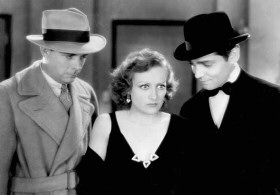 Dance,
Fools, Dance. MGM, 1931. Directed by Harry Beaumont, 82 minutes. Joan stars
as "Bonnie Jordan," a society girl forced to work as a cub reporter
and infiltrate the underworld after her father loses his money in the stock
market crash. Clark
Gable
co-stars as a crime boss; this is their first of 8 films together. Says
Joan in CWJC: ...a disaster
and I gave a lousy performance: the overacting thing again.
Dance,
Fools, Dance. MGM, 1931. Directed by Harry Beaumont, 82 minutes. Joan stars
as "Bonnie Jordan," a society girl forced to work as a cub reporter
and infiltrate the underworld after her father loses his money in the stock
market crash. Clark
Gable
co-stars as a crime boss; this is their first of 8 films together. Says
Joan in CWJC: ...a disaster
and I gave a lousy performance: the overacting thing again.
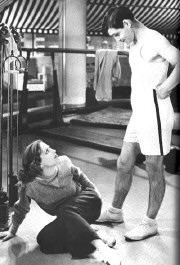 Dancing
Lady. MGM, 1933. Directed by Robert Z. Leonard, 94 minutes. Budget was $923,000
and production dates 6/33 - 10/33. (IMDb) Joan stars as
"Janie," a burlesque dancer trying to make it on Broadway, who's torn
between the gruff musical director of her show (Clark
Gable,
in their 4th film together) and a rich man who wants to marry her (future husband
Franchot
Tone,
in their 2nd film together). Fred Astaire makes
his film debut here as Joan's dance partner, and the Three Stooges are also
on hand. (Now that's entertainment!!) Says Joan in CWJC: ...great fun--Clark again, and a chance to dance with Fred Astaire
and sing a few pretty fair numbers. It was a hit.
Dancing
Lady. MGM, 1933. Directed by Robert Z. Leonard, 94 minutes. Budget was $923,000
and production dates 6/33 - 10/33. (IMDb) Joan stars as
"Janie," a burlesque dancer trying to make it on Broadway, who's torn
between the gruff musical director of her show (Clark
Gable,
in their 4th film together) and a rich man who wants to marry her (future husband
Franchot
Tone,
in their 2nd film together). Fred Astaire makes
his film debut here as Joan's dance partner, and the Three Stooges are also
on hand. (Now that's entertainment!!) Says Joan in CWJC: ...great fun--Clark again, and a chance to dance with Fred Astaire
and sing a few pretty fair numbers. It was a hit.
 Dassin,
Jules. (12/18/1911 - 3/31/2008)
Dassin,
Jules. (12/18/1911 - 3/31/2008)
Director Dassin began his
career as an actor in New York City's Yiddish Theatre, later writing radio scripts
and eventually getting hired to direct by RKO, then MGM. He was blacklisted
in the McCarthy era and moved to France, later settling in Greece after marrying
actress/politician Melina Mercouri in 1966. Perhaps his most famous films are
'48's The Naked City, '49's Night and the City, and '55's Rififi.
He also directed Joan and John Wayne in '42's Reunion in France, which
he talked about in 2002 in an interview with London's The Independent:
"Making it was hell," he admits, in
the sweetest of voices. "I managed to get a meeting with the MGM executives
because I was concerned about the casting and the script. But they only wanted
to talk about one thing. Hats. Hats were important. Joan Crawford is the
heroine of the French Resistance and is sacrificed for their existence in the
movie - I mean, she's captured and stripped of all dignity. And yet they wanted
to dress her "for the fans". And this was talked about for hours.
"Finally, I
got a word in and said I thought the script was bad. One of the executives took
me over to a window overlooking the parking lot and said, 'Which one is your
car?' I had this little old car at the time. And he pointed to his car, a big
new thing. And he said, 'That's my car and that's your car, and I say the script
is good'....On the first day we rehearsed,
John Wayne - a very interesting man, extreme right-wing but really just a
nationalist - was going through the script with Joan Crawford. It wasn't
going well, so, of course, I said, 'Cut'. And the whole set just froze.
"My
assistant panicked and pretended to call up at some imaginary guy, telling him
to be quiet. John Wayne took me to one side and muttered, 'Never say cut to Miss
Crawford. You just give a hand sign.' I thought this was just nonsense. But
when I said 'cut' again, Joan Crawford walked off the set, and Louis B.
Mayer called me to the office and fired me. But then Crawford rang me at my
house that night, and asked me to come to dinner.... And she asked me into the
library, where she had thousands of books, and she said, 'Mr Dassin, do you think
I'm a bad actress?' And I said, no, I don't. And she said, 'Don't ever say cut to
me again. Just do this'." Dassin pauses to draw two fluttering fingers across
his brow, like a diva having a neuralgia attack. "So that's what I did."...
But the problems didn't end after this rapprochement, which
saw him rehired. Quite quickly, Dassin discovered that Crawford was busy
avoiding her Dutch co -star Philip Dorn - he was an embarrassing ex-fling and
she'd just remarried. He began to notice that Crawford kept mysteriously moving
out of frame when she was in scenes with Dorn, so the camera would never capture
them together. "I got so mad," recalls Dassin, who was perched on a camera crane
at the time. "I jumped off the crane and the crane flew up - and I yelled, I'm
gonna punch you on the jaw'. And then that whole New York gangster thing came
out in her, and she took off her hat, and she put down her purse, and she
pointed to her jaw, and said GO AHEAD!'."
 Davis,
Bette. (4/5/08 - 10/6/89) See Whatever Happened to
Baby Jane for an extended
Joan-quote re Davis.
Davis,
Bette. (4/5/08 - 10/6/89) See Whatever Happened to
Baby Jane for an extended
Joan-quote re Davis.
Joan and Bette's first conflict seems to have been over Franchot Tone, with whom Davis worked and fell in love on 1935's Dangerous. (Tone and Joan married that year.) Part 2 of the feud was primarily a false media creation--"who's the queen bee?"--once Joan signed with Bette's home-studio, Warners, in 1944. Part 3 came about during the polite-but-tense filming of Baby Jane, and its aftermath (Joan's delight in Bette's Oscar loss; Joan's withdrawal from the subsequent Aldrich/Davis collaboration Hush, Hush, Sweet Charlotte). Despite their bickering, in CWJC Joan also says of Davis: "She can be such a bitch, but she's so talented and dedicated and honest." A must-read if you're interested in the feud topic: Bette and Joan: The Divine Feud, by Shaun Considine (Dutton, 1989).
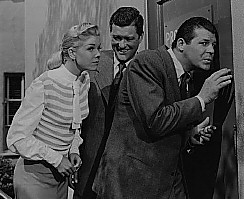 Day,
Doris. (4/3/24 - 5/13/19). American singing legend who also had
a memorable 39-film movie career (perhaps most famously appearing with Rock
Hudson in a series of light sex comedies, including 1959's Pillow Talk,
for which she received an Oscar nomination). DD and JC appeared in one
film together, 1949's It's
a Great Feeling--Doris starred with Jack Carson and Dennis Morgan,
Joan made a cameo appearance. Joan was also asked by Jack Warner to play
Day's sister in 1951's Storm Warning; Joan declined, and Doris's idol
Ginger Rogers took the role. (Said Joan at the time: "Come on, Jack.
No one would ever believe that I would have Doris Day for a sister.")
Day,
Doris. (4/3/24 - 5/13/19). American singing legend who also had
a memorable 39-film movie career (perhaps most famously appearing with Rock
Hudson in a series of light sex comedies, including 1959's Pillow Talk,
for which she received an Oscar nomination). DD and JC appeared in one
film together, 1949's It's
a Great Feeling--Doris starred with Jack Carson and Dennis Morgan,
Joan made a cameo appearance. Joan was also asked by Jack Warner to play
Day's sister in 1951's Storm Warning; Joan declined, and Doris's idol
Ginger Rogers took the role. (Said Joan at the time: "Come on, Jack.
No one would ever believe that I would have Doris Day for a sister.")
Some trivial connections the two women happen to share: both followed Christian Science beliefs, both were Aries, both had 4 husbands, both started as dancers...oh, and both appeared in blackface in a movie! (And thank you to Adrian for pointing out another connection: Both appeared in a movie with "Happened" and "Jane" in the title; we all know Joan's, and Doris's was 1959's It Happened to Jane---playing Doris's daughter in this movie was none other than the girl who played "Blanche Hudson" as a child, Gina Gillespie! Spooooooky!)
 Day,
Marceline. (4/24/08 - 2/16/00) Comedy actress of the '20s, one of Joan's co-WAMPAS Baby Stars of 1926. After
her career faltered, she retired from films in the mid-'30s. IMDb
info.
Day,
Marceline. (4/24/08 - 2/16/00) Comedy actress of the '20s, one of Joan's co-WAMPAS Baby Stars of 1926. After
her career faltered, she retired from films in the mid-'30s. IMDb
info.
Death Certificate. Joan's Manhattan death certificate lists her official cause of death as "cardiac arrest." Official time of death is 10 a.m. (May 10, 1977). Click here to see the certificate, courtesy of findadeath.com.
 Deatherage,
D. Gary. (6/3/41 - ) Deatherage was
born "Marcus Kullberg" and was adopted by Joan in 1941
(and re-named "Christopher Crawford" by her), but only
stayed with her for five months, after which his unbalanced natural
mother traumatically reclaimed him. (See also the Rebecca
Kullberg
entry.) When his mother gave him up a second time after a year of
abuse, he was adopted by a stable family and went on to a successful
military and personnel management career. In 1991, he published
the book "The
Other Side of My Life,"
about his search for his roots, in which he talks with his real
mother, father, and siblings---as well as Christina Crawford, Betty
Barker, and twins Cathy and Cindy---about his past.
Deatherage,
D. Gary. (6/3/41 - ) Deatherage was
born "Marcus Kullberg" and was adopted by Joan in 1941
(and re-named "Christopher Crawford" by her), but only
stayed with her for five months, after which his unbalanced natural
mother traumatically reclaimed him. (See also the Rebecca
Kullberg
entry.) When his mother gave him up a second time after a year of
abuse, he was adopted by a stable family and went on to a successful
military and personnel management career. In 1991, he published
the book "The
Other Side of My Life,"
about his search for his roots, in which he talks with his real
mother, father, and siblings---as well as Christina Crawford, Betty
Barker, and twins Cathy and Cindy---about his past.
Joan continued to talk about her five adopted children throughout her life and told Betty Barker that she hoped her lost son would one day find her.
De Havilland, Olivia. (7/1/16 - ) Veteran actress De Havilland took over Joan's role of "Miriam" in 1964's Hush, Hush, Sweet Charlotte after Joan feigned illness to avoid Bette Davis's rudeness.
Delano, Jorge. Chilean artist, writer, director, and journalist also known as "Coke." (He was also a 4th cousin of US President Franklin Delano Roosevelt.) Delano worked in Hollywood in the 1930s and 1940s, during which time he did caricatures of many Hollywood stars, including Joan, some of which were displayed at the Roosevelt Hotel on November 17, 1930. Click here to see a photo of Delano with Joan on the set of "Paid" in 1930, and to see a copy of the Roosevelt Hotel invitation.
Della. Pilot episode for proposed NBC series Royal Bay. See the 1960s TV page for more info.
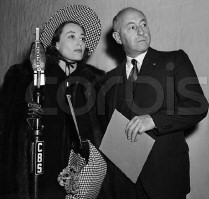 DeMille, Cecil
B. (8/12/1881 - 1/21/59) Co-founder of Lasky Pictures (Paramount)
in 1913, later producer of over 75 films, perhaps most famously 1923's The
Ten Commandments. (He also appeared as himself in '50's Sunset Boulevard.)
In addition, he also produced and hosted the Lux Radio Theater program from
1936 to 1945, on which Joan appeared with him 3 times.
DeMille, Cecil
B. (8/12/1881 - 1/21/59) Co-founder of Lasky Pictures (Paramount)
in 1913, later producer of over 75 films, perhaps most famously 1923's The
Ten Commandments. (He also appeared as himself in '50's Sunset Boulevard.)
In addition, he also produced and hosted the Lux Radio Theater program from
1936 to 1945, on which Joan appeared with him 3 times.
Says Joan in CWJC: DeMille produced spectacles, and he produced
them well. Big and gaudy. They had a place in the industry, and they made money,
but as far as real artistry is concerned I think you have to go back to 'big
and gaudy.'
Desiderata. Meditation written in 1927 (copyrighted 1952) by Max Ehrmann. The word is Latin for "something desired as essential." Joan cites it in MWOL as an inspiration for finding peace of mind. It was read at her funeral service. The text:
Go placidly amid the noise and the haste, and remember what peace there may be in silence. As far as possible without surrender be on good terms with all persons. Speak your truth quietly and clearly; and listen to others, even to the dull and the ignorant, they too have their story. Avoid loud and aggressive persons, they are vexations to the spirit.
If you compare yourself with others, you may become vain or bitter; for always there will be greater and lesser persons than yourself. Enjoy your achievements as well as your plans. Keep interested in your own career, however humble; it is a real possession in the changing fortunes of time.
Exercise caution in your business affairs, for the world is full of trickery. But let not this blind you to what virtue there is; many persons strive for high ideals, and everywhere life is full of heroism. Be yourself. Especially do not feign affection. Neither be cynical about love; for in the face of all aridity and disenchantment it is as perennial as the grass. Take kindly the counsel of the years, gracefully surrendering the things of youth.
Nurture strength of spirit to shield you in sudden misfortune. But do not distress yourself with dark imaginings. Many fears are born of fatigue and loneliness. Beyond a wholesome discipline, be gentle with yourself. You are a child of the universe, no less than the trees and the stars; you have a right to be here. And whether or not it is clear to you, no doubt the universe is unfolding as it should.
Therefore, be at peace with God, whatever you conceive Him to be. And whatever your labors and aspirations in the noisy confusion of life, keep peace in your soul. With all its sham, drudgery and broken dreams; it is still a beautiful world. Be cheerful.
Strive to be happy.
Die Mommie Die. Film written by and starring Charles Busch (based on his play of the same name), described by the NYTimes as a "sendup of Joan Crawford's late career as a horror movie star." Released October 31, 2003, in New York City and several other U.S. cities; shot in 18 days in June 2002. Busch received the 2003 Sundance Film Festival award for best performance in the lead role of "Angela Arden," and the film was chosen as the opening night selection at both the Miami and the San Francisco Gay and Lesbian Film Festivals. "Die Mommie Die" site.
Directors. Joan says in CWJC that the only four who ever helped or influenced her were Clarence Brown, Edmund Goulding, George Cukor, and Mike Curtiz. She added, re the role of the director in general:
I know that at this point in history it is very popular to give the director all the credit, and to minimize the script, the actors, and everyone else involved in production. This a cult thing that started in Europe, where the director did have absolute control because often he was also the producer and the writer and the guy who'd gotten the money together to make the picture in the first place.
Maybe this was true, in the very early stages, in this country, when a few men like Griffith and DeMille were more concerned with making art than making money. But the studios weren't interested in art unless it also made money, so the total emphasis was placed on turning out movies, like a factory operation, the public would pay to see...throughout the greater part of my career the director was less important than the cameraman or the gopher. This sounds like heresy, but I think it's true.
During the day of the big studio the money to make a film was supplied by the studio and whatever arrangements they made with banks. The producer involved was there to make sure the product pleased Louis B. Mayer. The director was on the job to please that producer. He had a snowball's chance in hell of doing anything that wasn't commercially kosher. So you can see how the director, until [Irving] Thalberg came along and shook things up a little, had the authority of a hamster... most of the directors I had during my first century at Metro had very little imagination, and I doubt that they could have done more than they did even if they hadn't been restricted. They were salaried employees, not creative persons, and their main duty was to get the picture done on time and within budget..
Robert Altman's films are usually terrible, and so are Stanley Kramer's, and Bogdanovich--my God, I haven't heard the phrase for years, but "artsy-fartsy" does it. They seem to be the prima donnas of filmmaking, but Christ, they're not Bergman. I think they'd be a hell of a lot more honest if they gave credit to the scriptwriter...and the actors who brought it to life. And the cameraman. And whoever is hired to edit. The whole goddam industry has forgotten the fact that a film is a team effort, and the public has swallowed this line. I don't think a really honorable director, like George [Cukor], would ever say, "This film is all mine." But most directors today seem to want to be little tin gods. It just isn't logical.
Disney Studios. See separate entries for cartoons in which Joan appeared: 1939's Autograph Hound and 1933's Mickey's Gala Premier.
Disney World. Here's a Sept. '07 report from a Joan-and-Disney fan (thanks, LG!):
I recently returned from my annual pilgrimage to Walt Disney World where I was on the lookout for references to Joan. The Disney-MGM Studios (to be renamed Disney's Hollywood Studios on January 1) has, appropriately enough, the most Joan material. There is a portrait of Joan that hangs prominently in the lobby of the Hollywood Brown Derby restaurant and I saw a picture of Joan from Rain hanging in a store at the park. There is also a plaque at the entrance to the Great Movie Ride commemorating her Oscar for Mildred Pierce. As for the ride itself, we get a brief glimpse of Joan in Our Dancing Daughters during the film montage at the end.
One of my favorite stores at Disney World is Sid Cahuenga's One-of-a-Kind, located in a bungalow just inside the entrance to Disney-MGM Studios. The shop offers original Hollywood memorabilia, such as autographs, photos, movie posters, and small props. This was the first time that I have visited the shop and they did not have anything pertaining to Joan. The clerk told me that she had sold an autographed photo of Joan earlier in the week.
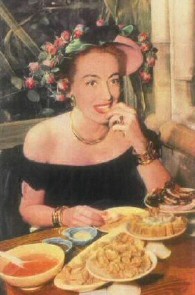 Don
the Beachcomber. Hollywood tiki-themed eatery first opened as a bar by Texas
native and bootlegger/wanderer Ernest Gantt in 1934, then expanded
to a restaurant across the street at 1727 N. McCadden Place
in 1937. (The
original restaurant closed in 1985; a new incarnation now exists
in Huntington Beach, on the Pacific Coast Highway.)
Don
the Beachcomber. Hollywood tiki-themed eatery first opened as a bar by Texas
native and bootlegger/wanderer Ernest Gantt in 1934, then expanded
to a restaurant across the street at 1727 N. McCadden Place
in 1937. (The
original restaurant closed in 1985; a new incarnation now exists
in Huntington Beach, on the Pacific Coast Highway.)
A favorite of many Hollywood stars, it was also frequented by Joan, and was the destination for some mother/daughter "date nights" when Christina was a child. In Mommie Dearest, Christina writes:
...my favorite place for dinner was Don the Beachcomber's in Hollywood. I loved the Polynesian food, the waterfalls, and the booth we always sat in which looked like a grass hut.
Pictured: A 1947 magazine publicity photo at the restaurant featuring Joan eating her "favorite meal" of "fried shrimp, egg roll and barbecued ribs."
 Dorn,
Philip. (9/30/1901 - 5/9/75)
Dorn,
Philip. (9/30/1901 - 5/9/75)
Born Hein van der Niet, this Dutch actor's film career lasted from
1934 to 1953. (A stage injury in '55 forced his performing retirement.) A film
idol in Holland and Germany, he came to the U.S. during World War II, later
retiring in Holland.
Dorn co-starred with Joan in 1942's Reunion in France. The two had had
an earlier fling and during their scenes together here, an uncomfortable
Joan constantly moved out of frame so that they wouldn't appear in the shot
together. (See the Jules
Dassin entry for a more complete account.)
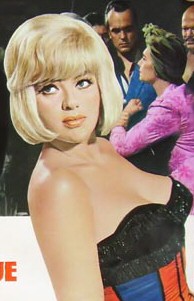 Dors,
Diana. (10/23/31 - 5/4/84) British sex-bomb and Joan's co-star
in 1968's Berserk!
In her 1979 autobiography Behind Closed Dors, Dors wrote
of Joan:
Dors,
Diana. (10/23/31 - 5/4/84) British sex-bomb and Joan's co-star
in 1968's Berserk!
In her 1979 autobiography Behind Closed Dors, Dors wrote
of Joan:
She was an incredible character, strange and puzzling, but whatever else a 'superstar' in her profession! As stated earlier, we worked together once in a film, and I can only speak from experience, beneath the dignified, strong exterior was a frightened, lonely woman. The stories circulating now about Joan Crawford, with the advent of the book written by her adopted daughter entitled Mommie Dearest, do tarnish the image a great deal and I find it hard to believe that the same woman who was concerned enough about me to telephone from America, when I nearly died of meningitis [my note: in 1974], is the same one who was capable of being such a monster to her children. All these terrible tales are possible however if she really was an alcoholic as we are led to believe, and from the various situations I witnessed on the set of the film we made, I am inclined to feel they are true.
Despite these there was humour to be found on some occasions. Producer Herman Cohen received an urgent call to her dressing room one day. 'Tell Miss Crawford I am just in the middle of a production meeting,' he said to his secretary, but back came the message that he had better do as he was commanded if he wanted the film to continue. Alarmed as to what the problem might be, Herman hurried to her room and found a thunderous Joan.
'Whatever is wrong?' he asked anxiously, and the whole story unfolded. As a director of the enormous Pepsi Cola firm, a role she had taken on after the death of her fourth husband Alfred Steele who had originally held the position, Joan decided that everyone on the film should drink as much of the stuff as possible, so she had graciously installed Pepsi Cola machines all over the studio.
'This gesture has been abused,' she announced to a trembling Herman that day.
'But I don't see what the problem is Joanie,' he cooed in his most sympathetic voice.
'The problem is,' screamed La Crawford, ' that out of the goodness of my heart I have arranged for everyone on this movie to drink Pepsi Cola free and they are treating me with scorn!'
'But Joanie dear,' Herman replied, pretending that even he drank the fizzy concoction himself, ' they all love you for it, and they are so grateful, so what is wrong?'
'I'll tell you what's wrong,' she snapped. 'No one is doing me the courtesy of bringing back their empty bottles.'
I do not know exactly how Herman soothed her feathers for she was obsessed by thrifty behaviour, such as saving flower vases which had contained blossoms sent to her, washing them out personally, and flying them back to New York in her luggage. The question then of others saving their empties, and returning them, was obviously a major issue in her mind, and I suspect Herman must have promised on oath that instructions would be sent out to everyone that the bottles must be returned on pain of death! After this confrontation not one empty Pepsi Cola bottle was ever seen lying around the set again.
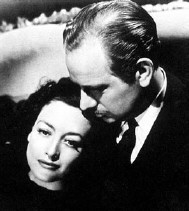 Douglas,
Melvyn. (4/5/01 - 8/4/81) Co-starred with Joan in '38's The Shining Hour, '41's
A Woman's Face, and '42's They All Kissed the Bride.
Douglas,
Melvyn. (4/5/01 - 8/4/81) Co-starred with Joan in '38's The Shining Hour, '41's
A Woman's Face, and '42's They All Kissed the Bride.
Said Joan in CWJC about his work in "Face":
Great
thanks to Melvyn Douglas; I think he is one of the least-appreciated actors
the screen has ever used. (Where would Garbo's "Ninotchka" have been
without him?) His sense of underplay, subordination, whatever you call it, was
always flawless. If he'd been just a little handsomer, a bit more of the matinee
idol type, he'd have been a top star.
IMDb
info.
Douglas, Mike. Joan appeared on The Mike Douglas Show on several occasions, including 9/24/68, when she came on with Christina to promote the just-released Films of Joan Crawford book. Said Douglas about Joan:
Joan
Crawford was an ideal guest. A lovely lady with fascinating stories. After
several appearances, she was comfortable enough to bring along her daughter,
Christina, an aspiring actress. It was another good show, with lots of happy
family talk. Years later that prompted me to give a guest a pretty rough
time for one of the very few times in my career when Christina Crawford was
scheduled to promote her tell-all book about her mother. Mommie Dearest
was not just an unpleasant breakthrough in publishing, precipitating an
avalanche of sordid family exposes. I only knew Joan Crawford from her
movies and her appearances on the show, but I didn't like the book. I'm old
school enough to still believe in family loyalty and the value of discretion when
it comes to dirty laundry. I remembered Christina's apperance ten years
before, when her mother tried to give her career a boost. Now, she was back
with a vengeance and the horror story of a mother from Hell.
Douglas, William O. U.S. Supreme Court Justice. He makes it into Joan-lore because of his 23-year-old wife, Cathy Douglas, whom Joan apparently blatantly snubbed during a White House dinner on January 17, 1967.
New York Daily News article. (Includes AP photo of both Cathy Douglas and Joan.)
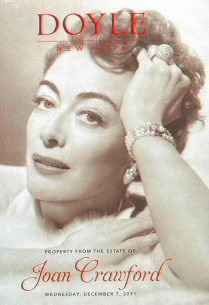 Doyle
New York. NYC auction house that sold 80 lots of Joan items
for $135,392 on 12/7/11. (Her Golden Globe was the highest-selling
item, going for $25,000.) See this site's page for the complete
list of items sold,
which also includes multiple pages from the auction program.
Doyle
New York. NYC auction house that sold 80 lots of Joan items
for $135,392 on 12/7/11. (Her Golden Globe was the highest-selling
item, going for $25,000.) See this site's page for the complete
list of items sold,
which also includes multiple pages from the auction program.
Dragon Lady, The. See Caniff, Milton.
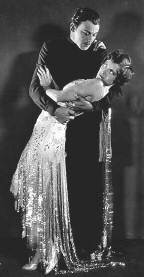 Dream
of Love. MGM silent, 1928. Directed by Fred Niblo, 65 minutes. Joan
plays a gypsy, "Adrienne," with whom a prince (Nils
Asther)
is smitten. Says Joan in CWJC: ...a mess--a bad script, no direction, no story worth mentioning.
Dream
of Love. MGM silent, 1928. Directed by Fred Niblo, 65 minutes. Joan
plays a gypsy, "Adrienne," with whom a prince (Nils
Asther)
is smitten. Says Joan in CWJC: ...a mess--a bad script, no direction, no story worth mentioning.
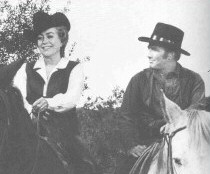 Drury,
James. Joan's co-star in the "Nightmare" episode of TV's "The Virginian,"
which aired 1/21/70.
Drury,
James. Joan's co-star in the "Nightmare" episode of TV's "The Virginian,"
which aired 1/21/70.
 Duane
Reade. National drug-store chain. In the spring of 2010, a Joan
quote appeared on the wall of their NYC Chelsea district store's makeup
wall: "I have always known what I wanted, and
that was beauty...
in every form." (Thanks
to Hart for the photo.)
Duane
Reade. National drug-store chain. In the spring of 2010, a Joan
quote appeared on the wall of their NYC Chelsea district store's makeup
wall: "I have always known what I wanted, and
that was beauty...
in every form." (Thanks
to Hart for the photo.)
 Duke
Steps Out, The. MGM silent, 1929, starring William Haines. Directed
by James Cruze, 62 minutes. Joan plays "Susie the Co-ed," whom millionaire-son-turned-boxer
Haines tries to woo. Says Joan
in CWJC: Metro was building Bill Haines
then, and this picture was created strictly for him. I might as well have stayed
home.
Duke
Steps Out, The. MGM silent, 1929, starring William Haines. Directed
by James Cruze, 62 minutes. Joan plays "Susie the Co-ed," whom millionaire-son-turned-boxer
Haines tries to woo. Says Joan
in CWJC: Metro was building Bill Haines
then, and this picture was created strictly for him. I might as well have stayed
home.
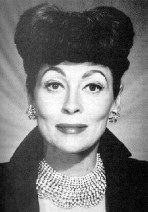 Dunaway,
Faye. (1/14/41 - ) Said Joan in Conversations with Joan Crawford of the '70s crop of up-and-coming stars: "...only Faye
Dunaway has the talent and the class and the courage it takes to make a real
star." Ahem.
Dunaway,
Faye. (1/14/41 - ) Said Joan in Conversations with Joan Crawford of the '70s crop of up-and-coming stars: "...only Faye
Dunaway has the talent and the class and the courage it takes to make a real
star." Ahem.
Anyhow, Dunaway's a deservedly acclaimed actress for
roles in such films as Bonnie and Clyde and Chinatown and Barfly, but will probably
be forever noted for her weird kabuki-esque take on Joan in 1981's Mommie Dearest. In the March 1990
issue of Ladies' Home Journal, Dunaway
admitted that she "overdid" Joan and also said:
That film was career suicide. It turned into an exploitation movie that verged on camp, and I'm still recovering from it. Going in, the role seemed tricky and interesting. I said "yes" because I listened to advice from someone in my private life - the last time I'll ever do that.While making Mommie Dearest, I woke up with nightmares about her...
IMDb info. TCM page. Wikipedia page.
DuPont Show of the Week. Joan narrated "The Ziegfeld Touch" episode, which aired on NBC on 10/29/61. See this site's TV page for more info.